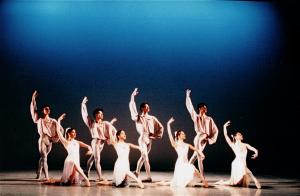Celebration (1995)
For piano and pre-recorded track with Hugh McDowell (cello)
Choreography: Christopher Gable
Lighting Design: Marion Mahon
First performed at the Lilian Bayliss Theatre, London, as part of the 1995 Ballet Central National tour,
and subsequently revised in 1999 by artistic director Greg Horsman, and in 2012 by Carole Gable.
For the Ballet Central Tour of 1995, the classical ballet choreography fell to artistic director Christopher Gable, whose reluctance to choreograph was legendary. Specifically opting not to use tutus, he created a neo-classical work for eight dancers, four girls and four boys, which explored the many facets of partnering. In fact his original title was ‘Partners’, until it was suggested that it sounded too much like a law firm, or a dating agency!
Certainly it provides one of the best examples of Gable’s discomfort at working from an abstract concept. Although the work has no narrative, it is full of all kinds of human dialogues and relationships that are characteristic of Gable and are treated with his enormous sensitivity (not to mention his fabulous musicality!) He called the sixth section, a short rumbustuous duet, the ‘divorce’ pas de deux, which shows how far away from the purely abstract he really was. Finding the partnering was getting a little too aggressive, the then artistic director, Matz Skoog, re-christened it ‘the Frolic’!
In fact Feeney’s original title for the score was ‘Electric Saint-Saens’ which gives a pretty clear idea where the music is located stylistically. The celebratory nature of the music is immediately announced by a triumphant bell directly after the piano’s first declamatory notes. The piece is in nine contrasting sections, all of which are based on those opening three notes, making it a kind of an exhilarating stream of consciousness adventure about things that can be done with the motive.
As befits the title, bells feature strongly in the piece, which is reflected in some of the subtitles of the sections, such as the gentle Schumannesque pas de deux entitled “Evening Bells”. Other ringing percussion is used, such as electronic glockenspiel and sampled crotales, and at the end of the pastoral fifth section, a pas de quatre, distant church bells can be heard. To the bells is added the beautiful lyricism of McDowell’s cello, which becomes increasingly present and acts as a romantic counterfoil to the pas de deux.
A part of the electric feel of this is due to the presence of two clavinovas, creating exciting by-play between the pianos. For the recording session, sound designer Ian Gibson hired an extra instrument and we experienced the curious sight of two pianos playing separate tracks simultaneously without a pianist in sight. Of course in performance, it was never really possible to match the sonority of the two pianos, especially with some of the, shall we say, more seasoned pit pianos found on tour.
In order to sync the track with the live piano, before the opening piano flourish there is a short click. On one unfortunate occasion at Wellingborough, the track was started before the composer had managed to make his way from the prompt corner to the pit, and it was necessary to start again. All the while the poor dancers were transfixed on stage!

